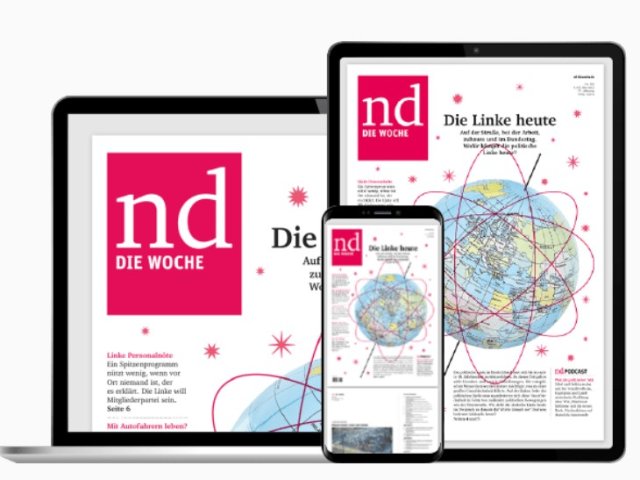European champion Bianca Schmidt (2nd from right) ended her active career in the summer. Now, as a team manager, she wants to help keep Turbine Potsdam in the Bundesliga.
Photo: imago/Felix Schliki
DFB President Bernd Neuendorf is a fundamentally optimistic person. “We have an exciting season ahead of us,” said the former politician last week at the opening event of the women’s Bundesliga in Dresden. The head of the association also raved about the attractive number of spectators for the reintroduced Supercup – almost 17,000 – as evidence of “how successful women’s football is.” In fact, the traditional club Dynamo Dresden also founded a women’s team after a trial day and could hardly save themselves from interested players. In the distant future, the club can imagine perhaps playing in the women’s Bundesliga. Could be easier and cheaper than for men.
It’s good for the league that the East will be represented again next season. FC Carl Zeiss Jena and Turbine Potsdam, both relegated teams from the previous season, immediately returned. Potsdam in particular, as a six-time German champion and two-time Champions League winner, still represents the times when women’s football clubs dominated. At some point, a renowned brand no longer seemed to be competitive in terms of sport and economy. With a 1:11 defeat at FC Bayern, Turbine disappeared from the upper house on May 28, 2023.
nd.Kompakt – our daily newsletter

Our daily newsletter nd.Compact brings order to the news madness. Every day you will receive an overview of the most exciting stories from the world Editorial team. Get your free subscription here.
But in Brandenburg they have made a virtue out of necessity. “We want to establish ourselves now,” says Turbine trainer Marco Gebhardt. “Our club has a tradition, but we have to remain humble.” President Karsten Ritter-Lang believes that we don’t have the worst chance of staying in the league. Due to the expansion of the league to 14 teams for the 2025/2026 season, there is only one relegated team. But in Potsdam they continue to live from hand to mouth and are desperately looking for a jersey sponsor.
Of course, the licensed clubs don’t have such worries under a men’s umbrella. At FC Bayern, the women’s department is now highly valued. President Herbert Hainer exclaimed from the town hall balcony at the championship celebration: “The goal, in the style of FC Bayern, is to come back here in 2025 with more titles.” Giulia Gwinn and Co. would also like to win the DFB Cup and the Champions League. But internationally, the Bundesliga is in danger of losing touch. In Lyon and Paris, Barcelona and Madrid, London and Manchester, salaries are rising rapidly, even if they don’t come close to the crazy salaries paid by men. In Germany, 62 percent of first division footballers earn less than 2,920 euros per month – this is stated in internal DFB papers. Only four percent have a monthly salary of more than 10,000 euros.
The Bundesliga currently ranks economically “just behind England, but ahead of Spain and the French,” said DFB managing director Holger Blask on the sidelines of the Supercup. The turnover of the entire league has increased to more than 25 million euros and the average audience to around 2,800, but it requires “a high level of investment to take the league to a completely different level.” After all, all games are broadcast. The streaming partners DAZN and Magenta Sport guarantee a wide range of offerings, and ten highlight games will be shown again on ARD and ZDF. There is also the Monday game on Sport1, which now starts at 6 p.m. The northern duel between VfL Wolfsburg and Werder Bremen begins next Monday.
But visibility is not a cushion, as Blask made clear. The DFB has written down an investment requirement of 135 million euros for the next ten years in a growth plan. In addition, many venues would need to be upgraded to have a more professional appearance. Are the licensing associations ready for this? Is a partner joining the DFB? These debates have been going on behind the scenes for months, because in addition to European champion England, Olympic champion USA in particular is showing what can be achieved in cooperation with media outlets and sponsors.
The US professional league NWSL is currently attracting more international stars. The equivalent of 54 million euros annually from marketing is ten times what the television contracts worth 5.17 million euros bring in Germany. Of course, it helps that women’s sports have broader social acceptance in the USA and that the college system gets girls excited about football.
This summer, top German clubs were happy to at least retain their German national players after considerable financial effort. Stars like Giulia Gwinn, Sydney Lohmann (Bayern) and Laura Freigang (Frankfurt) extended their contracts. The still injured top players Lena Oberdorf (Bayern), Sarai Linder and Janina Minge (both Wolfsburg) and Elisa Senß (Frankfurt) changed within the league. But top players from abroad were not included.
Overall, the league seems pretty predictable: Since 2014, FC Bayern and VfL Wolfsburg have taken all the silverware, while Eintracht Frankfurt has been third three times in a row. TSG Hoffenheim, Bayer Leverkusen, SC Freiburg, Werder Bremen and 1. FC Köln are satisfied with a solid midfield position. The training club SGS Essen, which recently came fourth, does outstanding work and only spends as much as it takes in. However, this is the exception: On average, every women’s Bundesliga team reported a deficit of 1.8 million euros in the 2022/2023 season.
Subscribe to the “nd”

Being left is complicated.
We keep track!
With our digital promotional subscription you can read all issues of »nd« digitally (nd.App or nd.Epaper) for little money at home or on the go.
Subscribe now!
judi bola online sbobet judi bola online slot demo
